| Name | Cooley Auricular Appendage Forceps |
| Lead Time | Lead time advised within 48 hours of order placement. |
| Specialty | Cardiothoracic-Cardiovascular Clamps |
| Material Finish | Stainless Steel |
| Grade | Premium Operating Room |
| Units of Measurement | Each |
| Manufacturer | Lexis Industry |
| Sterility | Non-Sterile |
| Usage | Reusable |
Cooley Auricular Appendage Forceps
Cooley Auricular Appendage Forceps
1-5/8″ x 3/8″ (4.1 cm x 1.0 cm) jaws, 10″ (25.4 cm)
Cooley Auricular Appendage Forceps are specially designed for use in cardiothoracic surgical procedures. These forceps have a wide application but are particularly well suited for use in manipulating auricular appendages. Each auricle leads into its respective atrium and thus this instrument is of use in surgical procedures that require access to the atria. The scissor handle grip allows for ease in grasping and manipulating this tool.
119
People watching this product now!
SKU:
EI-04-1018
Category: Cardiovascular Clamps
Description
Reviews (0)
Be the first to review “Cooley Auricular Appendage Forceps” Cancel reply
Related products
Cooley Neonatal Clamp
Cooley Neonatal Clamp
5" (12.5 cm)
Cooley Neonatal Clamp is the ideal tool for use in surgical procedures for newborn children. This clamp is build sturdily but made small enough to clamp the delicate vessels of a newborn child. This instrument is particularly well suited due to its ability to maintain a hold on the vessel without causing tears or rip on the delicate vessel walls of the newborn. Additionally, this clamp is available in a straight profile, spoon jawed, anastomosis clamp, carotid clamp or angled shank and straight jaws or curved shanks and angled jaws.
Beck Miniature Aorta Clamp – Stainless
Beck Miniature Aorta Clamp - Stainless
straight shanks, 6-3/4" (17.0 cm), debakey jaws, stainless
Beck Miniature Aorta clamp is designed for use in cardiothoracic surgeries. This miniature aorta clamp is ideally suited for use in neonatal or pediatric patients who have vessels that are too small to be handled by traditional sized instruments. This instrument can be used to clamp the aorta to occlude blood flow and prevent excessive bleeding during surgery. Additionally, this clamp is available with either DeBakey jaws or titanium jaws.
Cooley Tangential Occlusion Clamp
Cooley Tangential Occlusion Clamp
double angled jaws calibrated at 5.0 mm intervals, 7-3/4" (19.5 cm)
Cooley Tangential Occlusion Clamp is uniquely designed to clamp vessels in a way that reduces blood flow without completely stopping it in cardiothoracic surgical procedures. This clamp can be best used when doing procedures such as side-by-side anastomosis that required some blood flow. Additionally, this instrument features double angled jaws that are calibrated at 5 mm intervals making it possible to make accurate measurements during the procedure.
Cooley Patent Ductus Clamp – 6 1/4″
Cooley Patent Ductus Clamp - 6 1/4"
jaws calibrated at 5.0 mm intervals, 6-1/4" (16.0 cm)
Cooley Patent Ductus clamp is well suited for use in cardiothoracic surgical procedures. Specifically this clamp is designed for use in surgical procedures to repair a patent ductus. The jaws of this clamp are calibrated at 5 mm intervals and are designed for a firm surgical grip upon the vessels but is delicate enough to prevent any bruising or tears to the vessels walls themselves. This instrument is available with either straight or angular shanks making it possible to select the best fit possible for the procedure at hand.
Castaneda Clamp
Castaneda Clamp
curved shanks, long thin jaw, calibrated jaws, horizontal serrations, 6" (15.0 cm)
Cataneda Clamp is a versatile tool made for use in cardiothoracic surgical procedures for newborn babies. This clamps are designed for neonatal use and as much are much smaller than their traditional counterpart but are equally effective. This multipurpose clamp is designed with curved shanks as well as long thing calibrated jaws coupled with horizontal serrations. Additionally, this instrument is available at varying angles and as a multi purpose or partially occluding clamp making it easy to find a perfect fit for any surgical procedure.
Cooley Occlusion Clamp
Cooley Occlusion Clamp
curved jaws, jaws 3.6 cm long
Cooley Occlusion Clamp is designed for use in cardiothoracic surgical procedures. This clamp can be used to clamp vessels to reduce or stop blood flow to prevent the patient from losing an excessive amount of blood. The jaws allow for firm grasp of the vessels but with reduced risk of crushing or bruising to the vessel wall. Additionally, this clamp features curved shanks and jaws giving them a contour more suitable for use in vascular surgical procedures. This instrument is available in two different lengths to accommodate different vessel sizes and positions.
Cooley Miniature Multi Purpose Clamp
Cooley Miniature Multi Purpose Clamp
jaws calibrated at 5.0 mm intervals.
Cooley Miniature Multi Purpose Clamp is well suited for a variety of uses in cardiothoracic surgical procedures. Although this instrument does not have one particularly function but instead is a multi purpose clamp that can be used in a variety of different instances. The miniature size of this clamp makes it more able to reach certain vessels but also makes it better suited for use in smaller patients. This clamp comes equipped with jaws calibrated at 5 mm intervals and is available in three different angles 30, 60 and 90 degrees.
Cooley Cardiovascular Clamp – Fully-Curved
Fully-Curved
for temporary occulation of the iliac artery, 2-3/4" (7.0 cm) fully-curved jaws, 10-3/4" (27.3 cm)
Cooley Cardiovascular Clamp is ideally suited for use in cardiothoracic surgical procedures that require temporary occultation of the iliac artery. This instrument comes equipped with fully curved jaws making it particularly well suited for use in clamping vessels close to the diameter of the iliac vessels. The scissor grip handles and the ratcheting mechanism for keeping the clamp in place allows for this clamp to stay securely in place through the surgical procedure but is gentle enough to keep from injuring the vessel walls.


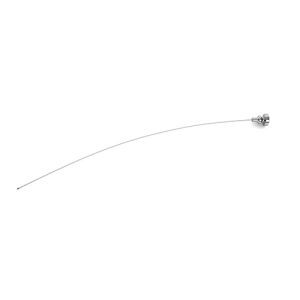
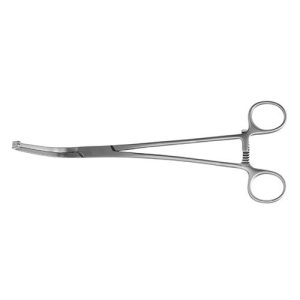

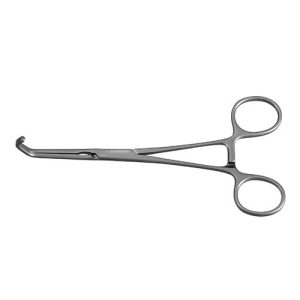
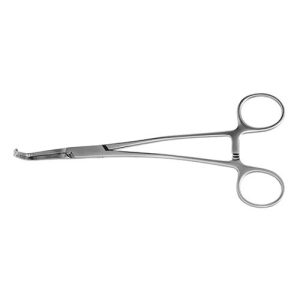


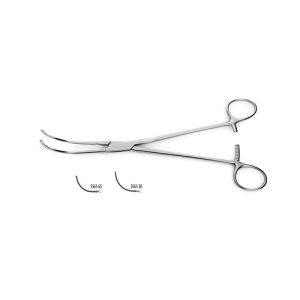
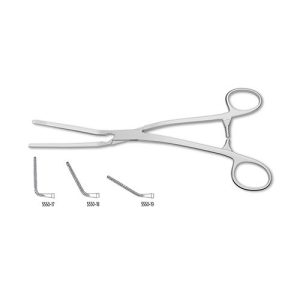
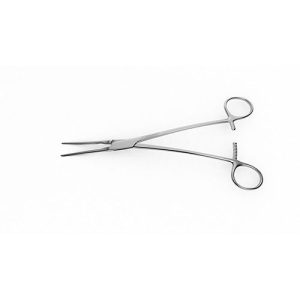


Reviews
There are no reviews yet.